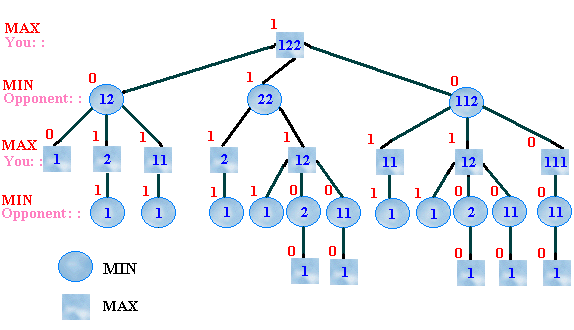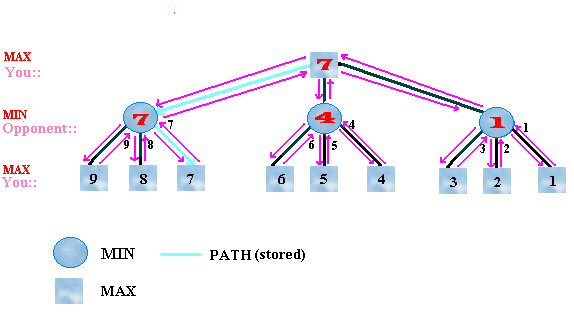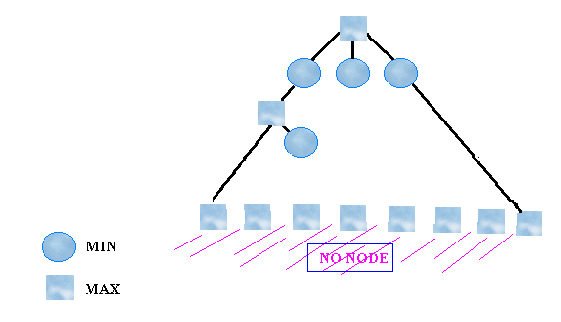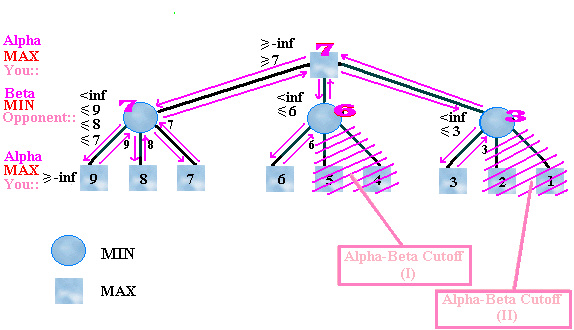DATA STRUCTURES AND ALGORITHMS
Topic #11: Game trees. Alpha-beta search
Game Tree
We will set up a framework for playing a two-person game in which
the two players alternate making moves.
The game can normally be represented as a tree where the nodes
represent the current status of the game and the edges represent
the moves. The game tree consists of all possible moves for the
current players starting at the root and all possible moves for
the next player as the children of these nodes, and so forth, as
far into the future of the game as desired. The leaves of the game
tree represent terminal positions as one where the outcome of the
game is clear (a win, a loss, a draw, a payoff). Each terminal
position has a score. High scores are good. For example, we may
associate 1 with a win, 0 with a draw and -1 with a loss.
Example : Game of NIM
In this game, several piles of sticks are given. We represent the
configuration of the piles by a monotone sequence of integers, such
as (1,3,5,7) or (2,2,3,9,110). A player may remove, in one turn, any
number of sticks from one pile of his/her choice. Thus, (1,3,5,7)
would become (1,1,3,5) if the player were to remove 6 sticks from
the last pile. The player who takes the last stick loses. The NIM
game (1, 2, 2) can be presented by Fig. 1. where 1 is a win and 0 is
a loss.

Figure 1: Game Tree for (1, 2, 2) NIM
In Figure 1 , the number in the root shows that in the
beginning there are five sticks which consists of three sets, 1,
2, 2. Suppose you are the player who makes the first move. You may
take one or two sticks. After your move, it is your opponent's
turn and the numbers in the nodes represent the sticks left. Then
the opponent moves one or two sticks and the status is shown in
the next nodes and so on until there is one stick left.
Now, we can use this game tree to analyze the best possible move.
For each player, the best move is to make the opponent lose and
make himself/herself win. So, one should make the move to get the
MAX score and force their opponent to get the MIN
score. A loss is represented by "0" and a win is presented by "1".
The MAX nodes represent the position of the current player
and the MIN nodes represent the position of the opponent.
Since the goal of this game is that the player who removes the
last stick loses, the scores are assigned to "0" if the leaves are
at MAX nodes and the scores are assigned to "1" if the
leaves are MIN. Then we back up the scores to assign the
internal nodes from the bottom nodes. At MAX nodes, choose
the MAXIMUM score among the children; at MIN
nodes, choose the MINIMUM score of the children as the
lower the score the better for MIN. So MIN is will
try to minimize the score in order to win while MAX will
try to maximize it. In this manner, we may compute the scores of
the internal nodes from the bottom up. In the example of figure 1,
the root node is "1", and thus corresponds to a win for the first
player. The first player should pick a child position that
corresponds to a "1".
MiniMax Game Tree
In a MiniMax tree, one can view in its entire form, the score values
at each of the levels of the tree at any given point during the
game. By viewing this tree, a player may be able to forsee which
moves are more advantageous and beneficial for themselves. The root
of the tree represents the position of the current player, thus,
depending on the number of levels that is to be searched, all odd
levels represent the first player while the even levels represent
the second player.
In a two player game, the first player moves with MAX
score and the second player moves with MIN score. A
minimax search is used to determine all possible continuations of
the game up to a desired level. A score is originally assigned to
the leaf, (usuall we do that when we reach a leaf), then by
evaluating each possible set of moves, a score is assigned to the
upper level by the minimax algorithm. The minimax algorithm
performs a preorder traversal and computes the scores on the fly.
The same would be obtained by a simple recursive algorithm. The
rule is as follows:
minmax(u)
{ //u is the
node you want to score
if
u is a leaf return score of u;
else
if u in a min node
for
all childern of u: v1, .. vn ;
return
min{ minmaxv1),..., minmax(vn)}
else
for all childern of u: v1, .. vn ;
return
max{ minmax(v1),..., minmax(vn)}
}
Note: If we know the scores of all the nodes, it would be futile
and boring to play the game because we would know the outcomes
already (against a clever opponent). The scores are the same as
the outcome of a game that would result in two infinitely clever
players would play each other starting from that position.
The complexity of the algorithm is equal to the number of nodes
in the tree.

Figure 2: Minimax Search
Figure 2 shows how the minimax algorithm works. There is a
game tree which consists of all possible moves. The root
represents the current player and the children of the root
represents the opponent. And the leaves contain the scores and
from there we assign score to the internal nodes by the minmax
algorithm. We want to find the best move for the current player.
So at the position of the current player, we choose the MAX score
of its children; and at the position of opponent, we choose the MIN
score of its children. Before the game starts the score for MIN
Nodes is set to +infinity and decreases with time. For MAX
nodes, scores starts with -infinity and increases with
time.
Bounded Lookahead in Large Tree
In large trees, it is quite impossible to search all the nodes. The
next best thing is to trim the tree to a few levels and pretend that
it is a good approximation of the (unknown) minimax tree by
assigning scores to its leaves. The difference now is that the
scores are no longer exact, but only educated guesses. The scores
obtained in this manner are said to be calculated with the aid of an
evaluation function. Evaluation functions are constructed by the
user based upon insight and experience. We may still employ the
minimax algorithm to go the required levels deep in the recursion
tree of moves, compute the scores at the leaves and then propogate
the score up the tree using the minmas algorithm: evalutemin (u) {//u in a min
node
if
u is a leaf then
return
the evaluated score of this leaf
else
let
v1,v2,v3, vn be the childern of U;
return
min { evalutemax(v1),....,evalutemax(Vn)}
}
evalutemax (u) {//u in
a mx node
if
u is a leaf then
return
the evaluated score of this leaf
else
let
v1,v2,v3, vn be the childern of U;
return
max { evalutemin(v1),....,evualutemin(Vn)}
}
 Figure 3: Large tree
Figure 3: Large tree
Alpha-Beta Search
ALPHA-BETA search is a method that reduces the number
of nodes explored in Minimax strategy. It reduces the time required
for the search and it must be restricted so that no time is to be
wasted searching moves that are obviously bad for the current
player. The exact implementation of alpha-beta keeps track of the
best move for each side as it moves throughout the tree.
We proceed in the same (preorder) way as for the minimax
algorithm. For the MIN nodes, the score computed starts
with +infinity and decreases with time. For MAX
nodes, scores computed starts with -infinity and increase
with time.
The efficiency of the Alpha-Beta procedure depends on the
order in which successors of a node are examined. If we were
lucky, at a MIN node we would always consider the nodes in order
from low to high score and at a MAX node the nodes in order from
high to low score. In general it can be shown that in the most
favorable circumstances the alpha-beta search opens as many leaves
as minimax on a game tree with double its depth.
Here is an example of Alpha-Beta search:

Figure 4: Alpha-beta search
At the MAX node we look at the score of its
children to make the best move. Initially the scores are not
assigned so we have to go down the tree to the leaves compute
their score and then carry the scores up the tree. Here the
MAX chooses the move with score 7 because in this case the
worst MIN can do is to minimize MAX's score to 7. If MAX makes
the move represented by the second child, MIN can minimize the
score to 6 which is less than the least score among the
children of the first child of MAX (noting that MIN will
always try to minimize the score). Hence MAX will not look any
further in this subtree for this move is clearly worse than
the first one. Same is the case of the third child of MAX.
Alpha-Beta algorithm:
(Corrected by Long Cheong, 2012.7.20)
An alpha-beta algorithm consists of two functions: evalutemin and
evalutemax. If calling from a MIN nodes, function evalutemin is used, while calling from a MAX
node, function evalutemax is used.
We begin with the MAX player by calling evaluatemax(u,
+infinity) where u is the starting position of the game.
evalutemin(u, B) //u is a
min node
Alpha=+infinity;
{
{
Return
Alpha; {
if
u =leaf return the score;
else
for
all children v of u
Val
= evalutemax(v, B);
alpha=
Min{alpha, Val};
if
Alpha<=beta then exit loop;
}
Return
alpha;
}
evalutemax(u,B)
// u is a Max node
{
alpha=-infinity;
if
u=leaf return the score;
else
for
all children v of u
Val
= evalutemin(v, B);
Alpha
= Max{Alpha, Val};
if
Alpha >= Beta then exit loop;
}
}
Java Applet
The following is a simple Java Applet Demo to demonstrate the
Minimax search shown in Fig. 2 .
The
source.
.
Links
References
- Levy, David N.L.: How Computers Play Chess, New York,
Computer Science Press, c1991. (This reference introduces the
game of chess and have well explanation of minimax algorithm and
alpha_beta cutoff)
- E.R. Berlekamp, J.H. Conway, and R.K. Guy: Winning Ways for
Your Mathematical Plays, Volume 2, Academic Press, London, 1982.
(This reference introduces the game of dots and boxes and is not
essential for doing the assignment.)
- E.M. Reingold, J. Nievergelt, and N. Deo: Combinatorial
Algorithms: Theory and Practice, Prentice Hall, Englewood Cliffs
NJ, 1977. (Good general reference on combinatorial algorithms
and on searching trees in particular.)
- N.J. Nilsson: Principles of Artificial Intelligence, Tioga
Publishing Co., 1980. (Good general reference on artificial
intelligence and on minimax trees.)
Web page creators
This web page was created by
Last updated August 9, 1999 Haroon Ali Agha
Copyright © 1997, Pui Yee Chan, Hiu Yin Choi, Zhifeng Xiao. All
rights reserved. Reproduction of all or part of this work is
permitted for educational or research use provided that this
copyright notice is included in any copy. Disclaimer: this
collection of notes is experimental, and does not serve as-is as
a substitute for attendance in the actual class.




